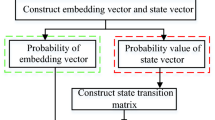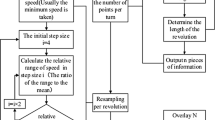Abstract
Aimed at the difficulty in fault diagnosis of wind turbine transmission system under variable working conditions, the paper proposes a novel health condition monitoring method based on correlative features domain adaptation. Firstly, the envelope analysis of the collected signals is carried out, and the time–frequency features of the signals are extracted to construct the feature set. The feature sets under the similar working conditions to target are selected as the auxiliary sample sets in source domain through the transferability evaluation. Then, a transformation matrix is found to adapt the marginal and conditional distributions of wind turbine sample data under different working conditions, and its weight is adjusted. While reducing the discrepancy between domains, the class imbalance problem is taken into consideration, so as to improve the accuracy of fault diagnosis under the target working condition. Finally, the classifier is trained with the adjusted source domain and tested in the target domain. Experiments show that the proposed method can effectively improve the accuracy of wind turbine fault diagnosis.
Graphic Abstract




Similar content being viewed by others
References
Chen, Y. J., Huang, G. Y., Shiah, Y. C., et al. (2020). Performance prediction for small horizontal axis wind turbine (HAWT) by integrated theory and experimental verifications. International Journal of Precision Engineering and Manufacturing-Green Technology, 7, 131–140.
Lu, X., McElroy, M. B., Peng, W., et al. (2016). Challenges faced by China compared with the US in developing wind power. Nature Energy, 1, 1–6.
Park, Y. J., Lee, G. H., Oh, J. S., et al. (2019). Effects of non-torque loads and carrier pinhole position errors on planet load sharing of wind turbine gearbox. International Journal of Precision Engineering and Manufacturing-Green Technology, 6, 281–292.
Ren, He., Liu, W., Jiang, Y., et al. (2017). A novel wind turbine weak feature extraction method based on cross genetic algorithm optimal MHW. Measurement, 109, 242–246.
Liu, W. Y. (2017). A review on wind turbine noise mechanism and de-noising techniques. Renewable Energy, 108(8), 311–320.
Yoo, C. H., Park, J. H., & Park, S. S. (2018). Design and evaluation of performance tester for yaw brakes in wind turbines. International Journal of Precision Engineering and Manufacturing-Green Technology, 5(1), 81–87.
Gao, Q. W., Liu, W. Y., Tang, B. P., et al. (2018). A novel wind turbine fault diagnosis method based on integral extension load mean decomposition multiscale entropy and least squares support vector machine. Renewable Energy, 116, 169–175.
Ren, He., Liu, W., Shan, M., et al. (2019). A new wind turbine health condition monitoring method based on VMD-MPE and feature-based transfer learning. Measurement, 148, 106906.
Kim, J. S., Lee, C. S., Kim, S. M., et al. (2018). Development of data-driven in-situ monitoring and diagnosis system of fused deposition modeling (FDM) process based on support vector machine algorithm. International Journal of Precision Engineering and Manufacturing-Green Technology, 5(4), 479–486.
Nguyen, T. P., Choi, S., Park, S. J., et al. (2020). Inspecting method for defective casting products with convolutional neural network (CNN). International Journal of Precision Engineering and Manufacturing-Green Technology, 77, 166–176.
Tang, S., Ye, M., Liu, Q., et al. (2016). Domain adaptation of image classification based on collective target nearest-neighbor representation. Journal of Electronic Imaging, 25(3), 033006.
Liu, Bo., Xiao, Y., & Hao, Z. (2018). A selective multiple instance transfer learning method for text categorization problems. Knowledge-Based Systems, 141, 178–187.
Wang, X., Ren, J., & Liu, S. (2018). Distribution adaptation and manifold alignment for complex processes fault diagnosis. Knowledge-Based Systems, 156, 100–112.
Liu, W. Y., & Ren, H. (2020). A novel wind turbine health condition monitoring method based on common features distribution adaptation. International Journal of Energy Research, 44(11), 8681–8688.
Sun, S., Shi, H., & Yuanbin, Wu. (2015). A survey of multi-source domain adaptation. Information Fusion, 24, 84–92.
Tong, Z., Li, W., Zhang, B., et al. (2018). Bearing fault diagnosis based on domain adaptation using transferable features under different working conditions. Shock and Vibration, 2018, 1–12.
Li, X., Zhang, W., & Ding, Q. (2018). A robust intelligent fault diagnosis method for rolling element bearings based on deep distance metric learning. Neurocomputing, 310, 77–95.
Lu, W., Liang, B., Cheng, Y., et al. (2017). Deep model based domain adaptation for fault diagnosis. IEEE Transactions on Industrial Electronics, 64(3), 2296–2305.
Zhang, R., Tao, H., Wu, L., et al. (2017). Transfer learning with neural networks for bearing fault diagnosis in changing working conditions. IEEE Access, 5, 14347–14357.
Gupta, A., & Barbu, A. (2018). Parameterized principal component analysis. Pattern Recognition, 78, 215–227.
Pan, S. J., Tsang, I. W., Kwok, J. T., et al. (2011). Domain adaptation via transfer component analysis. IEEE Transactions on Neural Networks, 22(2), 199–210.
Long, M., Wang, J., Ding, G., et al. (2013). Transfer feature learning with joint distribution adaptation. IEEE International Conference on Computer Vision, 1(2013), 2200–2207.
Zhang, Q., Li, H., Zhang, Y., et al. (2014). Instance transfer learning with multisource dynamic TrAdaBoost. The Scientific World Journal, 1(7), 1–8.
Shen, F., Chen, C., Yan, R., et al. (2016). Bearing fault diagnosis based on SVD feature extraction and transfer learning classification. In Prognostics and system health management conference IEEE, 2016.
Hartono, H., Sitompul, O. S., Tulus, T., et al. (2018). Biased support vector machine and weighted-SMOTE in handling class imbalance problem. International Journal of Advances in Intelligent Informatics, 1(4), 21–27.
Jian, C., Gao, J., & Ao, Y. (2016). A new sampling method for classifying imbalanced data based on support vector machine ensemble. Neurocomputing, 193, 115–122.
Wu, D., Lawhern, V. J., Lance, B. J. (2015). Reducing offline BCI calibration effort using weighted adaptation regularization with source domain selection. In IEEE international conference on systems 2015 (pp. 3209–3216).
Wang, J., Chen, Y., Hao, S., et al. (2017). Balanced distribution adaptation for transfer learning. In IEEE international conference on data mining 2017 (pp. 1129–1134).
Acknowledgements
This research was supported by the National Natural Science Foundation of China (Grant no. 51505202), the Natural Science Foundation of Jiangsu Province of China (no. 2020), the 333 Project of Jiangsu Province (2016-III-2808), the Qing-Lan Project of Jiangsu Province (QL2016013). We are also grateful to the editor-in-chief and reviewers for their kindly work to improve this paper.
Author information
Authors and Affiliations
Corresponding author
Additional information
Publisher's Note
Springer Nature remains neutral with regard to jurisdictional claims in published maps and institutional affiliations.
Rights and permissions
About this article
Cite this article
Liu, W., Ren, H., Shaheer, M.A. et al. A Novel Wind Turbine Health Condition Monitoring Method Based on Correlative Features Domain Adaptation. Int. J. of Precis. Eng. and Manuf.-Green Tech. 9, 191–200 (2022). https://doi.org/10.1007/s40684-020-00293-5
Received:
Revised:
Accepted:
Published:
Issue Date:
DOI: https://doi.org/10.1007/s40684-020-00293-5




